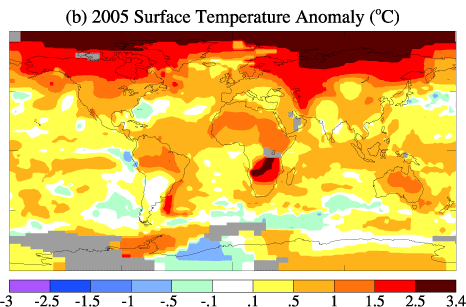(Part of the How to Talk to a Global Warming Skeptic guide)
Objection: Scientists claim that global warming from greenhouse gases is being countered somewhat by global dimming from aerosol pollution. They even claim that aerosol pollution caused the cooling in the mid-century. But GHGs are evenly mixed around the globe, while aerosols are disproportionately concentrated in the Northern Hemisphere. It follows that warming should be greater in the Southern Hemisphere — but that’s the opposite of what is happening. Clearly climate scientists do not know what is really going on.

Answer: Aerosol cooling does indeed affect the Northern Hemisphere, where most aerosols are produced, more than the southern hemisphere. It is also true that GHGs are well-mixed in the atmosphere — apart from a lag of a few years, southern hemispheric concentrations are rising just the fast as northern.
Where the argument goes wrong is in its assumption that uniform CO2 concentrations imply uniform heating.
It is completely in line with model expectations that CO2-dominated warming disproportionately affects the north. The reasons lie in those complications plaguing the climate system that everyone is so fond of highlighting when it suits the argument and ignoring when it doesn’t. This particular complication is well enough understood to explain what we observe.
GHG forcing has a greater effect over land. The ocean can absorb far more heat without warming nearly as much. It can distribute heat quickly in the upper layers via convection, moving the heat into lower waters rather than warming the upper waters. On land, most extra heat is transferred directly to the air, thus showing up immediately as greater atmospheric warming.
It so happens there’s a disproportionate amount of land in the Northern Hemisphere. The land area of North America, Europe, Asia, the Middle East, most of Africa and the top of South America are all in the north, while the south has Antarctica, Australia, and the rest of South America and Africa.
Another factor is differing ocean dynamics in the north and south. More heat mixes into deeper waters of the Southern Ocean. And sea-ice feedbacks are much greater in the arctic than in the Antarctic.
The arctic also exhibits a polar amplification, which has been observed and modeled. Real Climate has a good article on this.
In short, it’s simply incorrect to say we should see now, or expect to see later, more warming in the Southern Hemisphere. There are mysteries left to solve, but greater warming in the Northern Hemisphere is not one of them.

